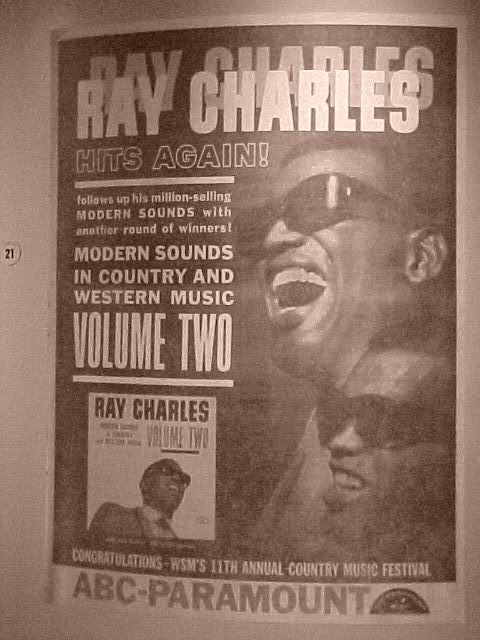- Bye Bye Love
- You Don't Know Me
- Half As Much
- I Love You So Much It Hurts
- Just A Little Lovin'
- Born To Lose
- Worried Mind
- It Makes No Difference Now
- You Win Again
- Careless Love
- I Can't Stop Loving You
- Hey, Good Lookin'
 |
| Clipping from JazzTimes, December 1994.* |
 |
| Liner notes of original album. |
Personnel:
The musicians' line-up for this album has - as far as I know - never been properly established. Traditionally, Hank Crawford is identified, on alto saxophone. trumpet player Al Porcino ("I used to get [Ray Charles] high on grass") was mentioned here. Carole Kaye remembers that Earl Palmer drummed on tracks #2 and #11. Members of Ray's big band may have been involved in the New York sessions. The (much stiffer) symphonic strings and choir parts were no doubt done in Hollywood.
Arrangers: Gil Fuller (#3, 8), Gerald Wilson (#1, 5, 10, 12); Marty Paich (#2 ,4, 6, 9, 11). Sid Feller, Ray Charles – producers.
Recorded on 5 and 7 February 1962 at Capitol Studios in New York City, and on 15 February at United Recording Studios in Hollywood.
The album was discussed in this entertaining radio show, the Matt Glaser Record Party - Episode#1, on BIRN1 (guest Jay Peterson) on July 29, 2012.
Soundclip Vol. 1 & 2:
* Photographer William Claxton's story (read the caption to the clipping) can't be accurate. The year (1962), the location ("Hollywood") and the anecdote about the harp point to ABC (not Atlantic), and probably to a recording session for Modern Sounds.
B) Modern Sounds In Country And Western Music Volume Two (October 1962)
- You Are My Sunshine
- No Letter Today
- Someday (You'll Want Me To Want You)
- Don't Tell Me Your Troubles
- Midnight
- Oh, Lonesome Me
- Take These Chains From My Heart
- Your Cheating Heart
- I'll Never Stand In You Way
- Making Believe
- Teardrops In My Heart
- Hang Your Head In Shame

 |
| Recording with Sid Feller (from album cover). |
Side 1 was recorded with his big band and The Raelettes, playing charts arranged and conducted by Gerald Wilson in New York. Side 2 features lush orchestral arrangements with a string section and charts arranged and conducted by Marty Paich in Hollywood. This 'sandwich' formula became a pattern for many later albums.
Side 1 (tracks #1 - 6) was recorded on 5 September 1962 in New York. The tracks of side 2 were taped in Hollywood on 7 September 1962.
 |
| Working with Hank Crawford; poss. at New York session. Photo by Howard Morehead. |
%2BHoward%2BMorehead%2B-%2B196208.jpg) |
| Ray Charles, Sid Feller, Gerald Wilson at New York (rehearsal?) session. Photo by Howard Morehead. |
 |
| Margie Hendricks and Ray, prob. in New York (rehearsal session or real session). Photo by Howard Morehead |
Marty Paich, Ray Charles, Joe Adams at the Hollywood session. Photo by Howard Morehead.%2BHoward%2BMorehead%2B-%2B1962.jpg) |
| Photo by Howard Morehead @ United Studios in Hollywood, on September 7, with the Jack Halloran singers. |
Remastering engineer Steve Hoffman commented on the photo above:
"Notice the separation of the boys from the girls? On the "string side" recorded at United for C&W Volume 2, engineer Al Schmitt (unlike the first album by Bill Putnam) spread the chorus in stereo for those songs only (never again on any Ray recording, either). I never realized they were so close to Ray. The giant cavern echo makes it difficult to imagine the setup but that pic brings home the fact that everyone was close to each other so they could hear without headphones. Totally neat."Hoffman also wrote that:
"On the 'string songs': the ones that were recorded by Bill Putnam in Feb. 1962 have the choir all the way over to the right and they sound like they are stuck behind a curtain for the most part. The string sound has echo that is rich and deep and Ray's vocal mic is slightly muted on the top end as to not to clash. This is typical of Bill Putnam's engineering style.ABC/Paramount 435, October 1962.
Now, the string songs that have the choir split in stereo, some on the right and some on the left were recorded in the same room at United later on in the year but Al Schmitt was the engineer. So if you want to tell the difference between the two, that's the easy way to tell. Al's mixes are more hi-fi (Take These Chains From My heart, Your Cheating Heart) but less charming than Bill Putnam's (You Don't Know Me, Born To Lose). Two different styles [of engineering] on the same material. Fun to compare [...]."









Thank you for assembling this. Just answered a few bar bets.
ReplyDelete